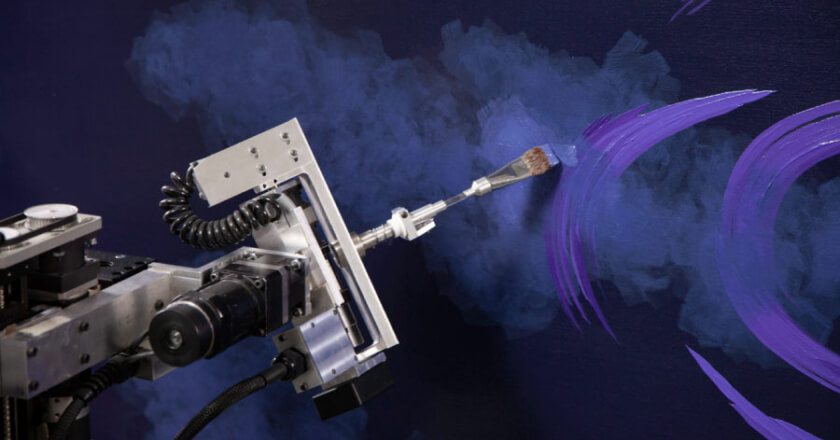Get Inspired
Build the life you love. Learn more about fusioneering:

Posted on November 17, 2023 in Painting for Beginners
In the realm of visual art, each stroke of the brush, each texture created, and every color applied carries the potential to convey emotions, stories, and beauty. To shape these elements, painters aren’t just using brushes — in fact, your favorite effect or “brushstroke” in your favorite painting may have been made by something else: the palette knife. These simple metal tools might just serve as a gateway to elevating your artwork through texture and visual effects.
Ready to delve into the fascinating realm of palette knives? Read on for our painting tips!
Read More: The Right Paintbrush Makes All the Difference
Palette knives are versatile tools with flat, flexible, elongated steel blades. They come in various shapes and sizes — some resembling spatulas, others trowels — each serving a unique purpose in the painter’s creative process. These tools are used for mixing colors on a palette, as their name implies, but they’re also used to apply paint directly onto the canvas to sculpt, blend, and create captivating textures.
Related: Pick the Best Paint Type for Your Work
It’s important to choose the right palette knife for your project. While it might not initially seem to matter, the shape of the blade will greatly influence the type of texture you can achieve. Here are some common palette knife shapes and their applications:
Remember, experimentation is often one of the best teachers, and your experience with different palette knives will vary. There’s no right or wrong way to incorporate these tools into your painting, so have fun and explore the options. Try them all to find what works best for you!
Related: Learning New Skills is a Snap with a Growth Mindset
Now, let’s explore some painting techniques that use palette knives to create texture and visual effects.
To start — do you mix your paint colors with the head of your brush? Or maybe a bit of wood? Time for a dedicated, easy-to clean, paint-mixing tool! A simple palette knife should be your go-to for mixing colors. They’re easy to control, and cleaning is as simple as wiping off with a paper towel or rag for oil paints and washing with soap & water for acrylics.
Palette knives are also excellent tools for blending and mixing colors directly on the canvas. This technique can produce smooth gradients, soft transitions, and captivating visual effects.
Impasto is a technique where the artist applies paint to the canvas in a thick and heavy manner, creating a three-dimensional, raised surface. This technique creates a sculptural quality that adds depth, texture, and a tactile element to your artwork. The thick consistency of oil paints makes them particularly well-suited for this technique, though it can also be applied in acrylic and other painting mediums.
The term “sgraffito” is derived from the Italian word “sgraffiare,” which means “to scratch.” In the context of painting, sgraffito is a method in which a top layer of paint is scratched or scraped away to reveal the underlying layer, creating intricate and often contrasting designs or patterns. You can create detailed and precise designs, or more spontaneous, abstract patterns through this process.
Here’s something a little different! Textured collage is a mixed media technique that combines traditional painting with the addition of various textural materials to create a tactile and visually captivating artwork. Palette knives play a crucial role in sculpting, spreading, and manipulating these textured elements.
Too often, we become caught-up in the idea of what is “right” or “wrong” in regards to artistry. However, throughout history, it has been the rebel artisans who have redefined beauty and visual style. The palette knife is not a hammer, designed with only a simple use in mind; the palette knife is the manifestation of visual intrigue and exciting new horizons in painted art. By selecting the right knife, experimenting with techniques, and practicing, you can unlock a world of creative opportunities — some perhaps never used before.
Ready to embrace the palette knife as an invaluable addition to your artistic toolkit?
For more exciting information on art, science, and the new frontiers of both, stay tuned-in to The Kirby Foundation. Updates can be found on our Instagram, Facebook, and Pinterest pages.
Are you interested in hearing the complete story of Paul and Dulcinea? Watch the video (nominated for Best Short Film at the 2021 Vail and Portland Film Festivals) for more info.
Want to be the first to know about every exciting new project at the Kirby Foundation?
Join Our Mailing ListBuild the life you love. Learn more about fusioneering:
Why pick which passion you should follow? Fusioneering allows you to cultivate many interests into something innovative and revolutionary.

Meet Paul and explore how blending your interests can empower you to follow your enthusiasm and bring your passions to life.